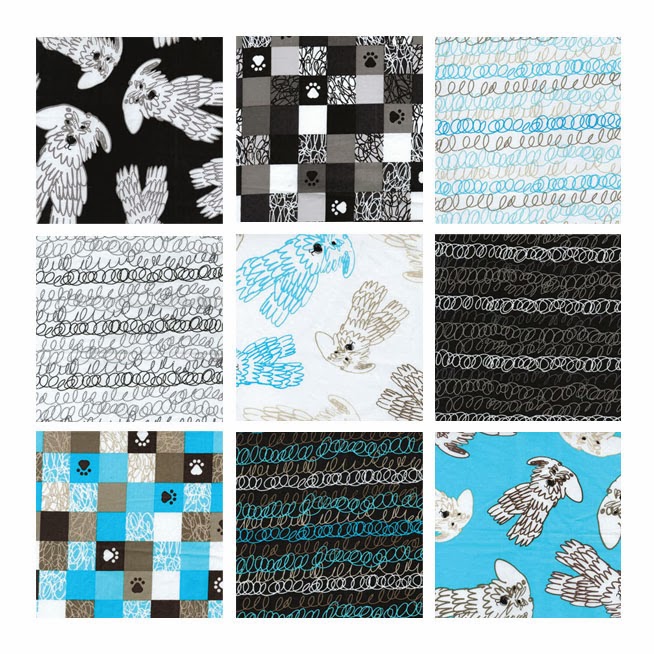Welcome back for Day 4 of our Kids' Quilts Blog Hop! Today Sarah from Confessions of a Fabric Addict is here, sharing a tutorial for a one-block quilt using the Yard Dog collection from Kanvas. Sarah will also tell you about her involvement in charity quilt giving, and is hosting her annual charity quilt challenge on her blog beginning in March. Enjoy the tutorial, and don't miss the chance at the bottom of this post to enter to win a FQ bundle of Yard Dog.
Hi, all! I'm Sarah, and I blog over at Confessions of a Fabric Addict. I'm just thrilled to have been asked to be a part of this blog hop!! Quilts for children is kind of a passion of mine - I think because it lets me work with fun prints and lots of color!
Most of the quilts I make are given away, to both children and adults. I work with a growing quilt ministry in my church, and also host a charity quilt challenge on my blog each year. This will be the fourth year for the Hands2Help Charity Quilt Challenge. In the past three years, we have involved 167 quilters who have donated 281 quilts to various charities, including quilts for orphans in Romania, Russia, and Ethiopia, chemotherapy patients, and hurricane survivors in New Orleans. This year's Challenge starts on March 16th, with signups all week and a signup giveaway on March 23rd. I hope you'll consider joining in the fun - and you could use this tutorial as your design!
When I was asked to do a tutorial for this hop, I wanted to come up with a design that was simple but interesting, and that could be made with yardage, precuts, or scraps. This one-block quilt tutorial is for a child-sized quilt, but this also would be easy to make larger or smaller by simply reducing or increasing the number of columns and blocks in each column. Enjoy!!
Floating Boxes Tutorial
 |
| Beautiful "Yard Dog" fabrics! |
Solid: 1 3/4 yard for "A" block centers, outside of 7 "B" Blocks, strip ends, and borders.
 |
| "A" Block |
 |
| "B" Block |
A and B blocks:
Borders:
Binding:
Stitching on the long right-hand side of the 4.5” piece, stitch approximately 1” down, backstitch and remove from the sewing machine. This is a partial seam that you will finish later.
Now you can finish the partial seam you made in the first step.
Your top is finished! Quilt as desired and bind, then find a lucky child to enjoy it!
This quilt can easily be made smaller or larger by adding or subtracting blocks. You can see examples of this on my blog post today. Also, if you'd like to receive a PDF version of this tutorial, please stop by my blog, Confessions of a Fabric Addict, and leave me a comment with your email information. I'll email it to you right away! If you request one and don't hear from me, it's possible you are a no-reply blogger - just email me directly at the address you'll find on my blog!
Thanks for letting me share this tutorial with you!! Be sure to check out the rest of the great tutorials that have been shared this week, too! And remember to come by and join in the Hands2Help Charity Quilt Challenge - signups begin March 16th!!
Thanks Sarah!
For a chance to win a fat quarter bundle of the Yard Dog collection, simply sign up to follow this blog, either through Bloglovin' (or another blog reader service) or email (both options are in the right hand sidebar) and leave a comment letting us know you follow. In your comment, since the fabric featured today is Yard Dog, let us know--are you a dog person? cat person? neither? Leave a second comment and receive a second entry by following us on Facebook and letting us know. This giveaway is open through Monday, March 3 at 11:59 PM EST.
Make sure you check out all the tutorials from the Kids' Quilts Blog Hop:
Day 1: by the Benartex Blog Team, featuring Monkeying AroundDay 2: by Nikki from The Girl Who Quilts, featuring English Rosey
Day 3: by Emily from Mommy's Nap Time, featuring Doodle Dog
And check back on Monday, when we'll share some additional free pattern ideas for kids' charity quilts, as well as a list of links of other charities accepting quilts for kids.
























.jpg)
.jpg)





